
Some of you might be wondering why many of these new hero books started off in other titles, like Flash in Showcase #4, Spider-Man in Amazing Fantasy #15, when today a comic with a #1 on it has a big boost in sales.
Back then things were different. Newstands only wanted established titles, something they knew would sell. Many were not willing to take a gamble on a brand new title. So to bypass this obstacle, comic companies created comics like Showcase and Amazing Fantasy and put out a wide variety of stories in them.
So when it came to introducing new heroes, they put most of them in established titles. If the heroes were popular, they had them re-appear in those titles. Eventually the comic companies just changed the name of those titles to the hero's name and kept the numbering of the series the same so that newstands would keep ordering the titles.
Here are some of the major titles from the Silver Age that had a major effect at the time. These titles either debuted and/or launched major heroes and teams into their own titles.
Showcase is well known for bringing in The Flash and
starting the Silver Age.
This comic is also responsible for bringing a slew of other heroes and
teams. In Showcase
#17 (November 1958) a hero called Adam Strange appeared. Adam
Strange was an
archeologist on the run from angry savages in South America when out of the
blue, he was zapped by a Zeta beam and transported to Rann, another planet
4.3 light years away from Earth. On Rann, Adam would save the planet from
various threats like alien invasions, civil wars, natural disasters and so
forth. Adam Strange had no superpowers, all he had was quick
thinking and advanced Rann technology. With that he did heroic deeds and
was a celebrated hero
on Rann. He also fell in love with one of it's inhabitants, Alanna. Adam
was not able to stay on Rann for long. After a while the Zeta beam would
wear off and he would return to Earth. He would then try to predict
where the beam would strike next so he could go back to Rann,
to be with Alanna and save her world when needed.

The Silver Age Green Lantern appeared in Showcase #22. It
was published in September 1959. In this issue Hal Jordan meets a dying
alien named Abin Sur, who is member of the Green Lantern Corps. The
"Corps" is an intergalactic space patrol that polices the universe using
powers given to them by a green ring. The ring's power is recharged by a
green lantern. Abin Sur asks Hal Jordan to take his place in the "Corps"
and patrol his sector of space. Hal Jordan agrees and takes an oath..
"In brightest day
In blackest night
No evil shall escape my sight!
Let those who worship evil's might
Beware my power -
Green Lantern's light!"
The new Green Lantern was edited by Julie Schwartz (who did
The Flash), written by John Broome and drawn by Gil Kane. The
origin is found in a book called Skylark Patrol written by E. E.
Smith. Gil Kane also did something different with the new Green
Lantern.
He decided not to use the typical cape and belt that most flying superheroes
had, and gave Green Lantern a more modern, sleeker look.
This revamped version of Green Lantern was able to do almost
anything. Like the Golden Age Green Lantern, he could fly, become
intangible (like a ghost) and blast green force bolts. In fact, Green
Lantern could do almost
anything! The only things limiting his powers were his imagination.. and
the color yellow. The Green Lantern power ring could not affect anything
the color yellow. This weakness was added in case a Green Lantern
turned to evil,
they could be defeated by the "Corps" and brought in for their dirty deeds.
The Green Lantern would get his
own series starting July 1960.
Showcase #34 would bring in another hero called Atom.
He is Ray Palmer, a physics professor who, through his costume, could
change his weight and shrink down to the atomic level! His costume used
properties gained from a white dwarf star. The Atom would later
become a member of the Justice League of America (you will learn of
them later). After he was de-aged into a teen-ager Atom
lead the Teen Titans (you will also learn about this team soon).
The Atom got his first series in June 1962.
The Spectre would re-appear in the Silver Age in Showcase
#60 (January 1966). Spectre was one of the few golden age characters
that DC did not revamp. This Spectre is the same Jim Corrigan that
you read about in the Golden Age. He would go on to his own series in
November 1967.
Showcase #75 (June 1968) brought in a superhero duo called Hawk and Dove. This original team had two brothers known as Hank and Don Hall. Their father was Judge Hall, who was kidnapped by Dargo, a crime boss. When a group of villains locked the two brothers in a room, both tried to get out and free their father, but they couldn't. Then two voices appeared. The two voices were entities known as the Lords of Order and Chaos. They promised the two boys powers but only if they used them for good. But the powers would immediately disappear once the threat was over. The two boys agreed and were given their powers. The Lord of Chaos would give Hank Hall the ability to turn into Hawk, who had super strength, endurance and was an excellent fighter. Dove was given his powers by the Lords of Order. He had a bit of super strength, and some healing powers. But he also had "spatial awareness"; he knew the qualities (weight, location) of all objects in an area. Later on, this Dove was killed and the Lords or Order gave the powers to a woman that Hank Hall was attracted to. The new female Dove would eventually get other powers like flight, agility, intuition, a "danger sense", the ability to see into possible futures and intelligence. Hawk and Dove would get their first series in August, 1968. Later Hank Hall would turn into a villain called Monarch and then into another one called Extant.
The Brave and the Bold is another DC title that had a strong
impact in the DC universe. This title was better known for bringing
in superhero teams than individual heroes. The first of these teams was
Suicide Squad. They first appeared in The Brave and the Bold
#25 (August 1959). The first squad had Richard Flag assigned to
command a group of misfits and outlaws and take them on suicide missions.
The group survived their missions and would later evolve into very successful
soldiers. There would be two other incarnations of the squad, without
superheros on either of them. One would split into two groups and fight
problems domestically and internationally. The other would fight off alien
invasions.
In 1986, during a Legends mini series a new
Suicide Squad, now with super powers, would be formed and they would
get their own title one year later.
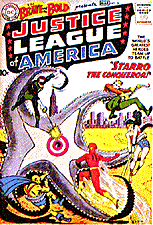
Well, it worked with the Justice Society of America, so
DC Comics gave it another try with this comic. The Brave and the Bold
#28 (February 1960) featured The Justice League of America. Their
ranks included The
Flash, Green Lantern, Martian Manhunter, Wonder Woman, and Aquaman. They
would become the most popular superhero team in the DC universe. From time
to time their members would
change and include other big and small name heroes. They would soon get
their own comic starting in October 1960.
The Brave and the Bold #34 (February 1961) re-introduced a hero
called
Hawkman to DC comic readers. Hawkman was originally a bird
watcher on an alien planet called Thanagar. To better watch birds, he
built a set of wings that allowed him to fly so he could see birds in their
natural element. Then crime struck his home planet and Hawkman was
asked to
use his wings to stop the criminals. He agreed, and thus and became
Thangors first
policeman. On Thangor, Hawkman would battle criminals for 10 years
until
one stole a space ship and tried to escape from the planet. Hawkman
and his wife Hawkwoman got aboard the space ship as it
headed off. The ship would go into hyperdrive and would end up on Earth.
After catching the criminal, the two were allowed to stay on Earth to
learn about human policing methods. Hawkman's own series started in
April 1964.
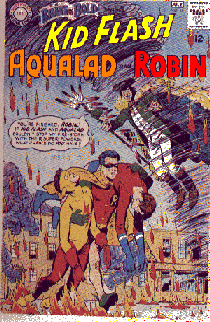
The Teen Titans would first appear in The Brave and the
Bold #54 (June 1964).
This team was made up of sidekicks or younger versions of major DC heroes.
In this issue there are only three sidekicks. Aqualad, Kid Flash, and
Robin.
Later, the Teen Titans would get more famous members and would grow
in popularity.
Some of the later members include Wonder Girl, Speedy and
Hawk. In January, 1966 the Teen Titans would have their own
series.
The last issue of The Brave and the Bold, #200 (July 1983) held
true to form with the first appearance of a superhero team called The
Outsiders. This team
would feature heroes like Batman and Black Lighting (you'll read
about him in Part 3). This team also had heroes like Metamorpho, Geo-Force,
Looker, Halo, and Katana. They would also get their own series in 1985.
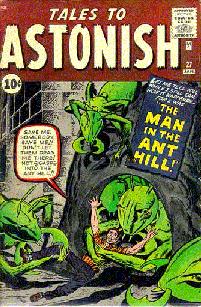

Tales to Astonish was a Marvel title that was used to publish many
heroes. In Tales to Astonish #27 (January, 1962) we first meet Henry
Pym, an ordinary man
who has shrunk to the size of an ant. We later find Henry Pym as Ant
Man in
issue #35 (September 1962). Henry would also join The Avengers and have
many different powers and superhero names in the future.

In Tales to Astonish #44 (June 1963), we first see Janet Van
Dyne, The Wasp.
She too would become one of the founding members of The Avengers and
eventually
lead Earth's Mightiest Heroes for a time. In Tales to
Astonish #49 Henry Pym
goes into the first of several changes and turns into Giant Man.
Later, in #52
we see the Black Knight for the first time. He too would become a
member of The Avengers and is currently found in Heroes for
Hire.

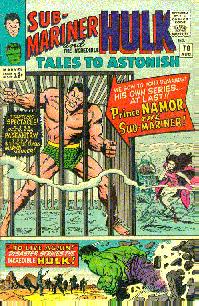
This title would go through several changes in the future, including
replacing
the main characters with other Marvel superheroes. In September 1964,
Tales to Astonish
#59 has the Incredible Hulk appear. This character originally
started out with his
own title but after 6 issues the series was cancelled. Directly after this
issue (Tales to Astonish #60)
The Hulk would have his adventures in half of the comic. In #70,
Namor, the Sub-Mariner would take over Henry Pym's part of the comic.
With issue #102, the title of this comic changed to Incredible Hulk.
Namor would move on into a shared one-shot title called Iron Man
and Sub-Mariner
(April 1966), then would go on to his own series called Prince Namor, The
Sub-Mariner which started in May of 1968.
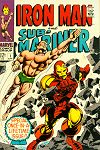

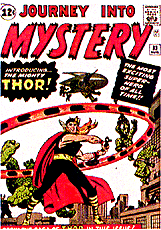
Thor, the God of Thunder first appeared in Journey into
Mystery #82
(Cover dated August 1962). He was different than other heroes because he
was a mythological God. By bringing in Thor, other mythological figures
followed. This opened up comics to new stories and characters that were
mythology-based. Thor did have a human side.. or at least part of
the time. In this issue Dr. Donald Blake goes for a vacation in Norway.
While there, he is attacked by Rock Men from Saturn. During the invasion,
Dr. Blake falls into a cave and is trapped there without his cane, with a
giant boulder blocking his only exit. Finding a wooden stick in the cave, he
attempted to get free with it. This didn't work, so in anger, he strikes the
boudler with the stick. At that moment Dr. Donald Blake turns into the
mighty Thor, who then easily gets out of the cave, and defends our
planet from the attacking aliens. From that issue on, Thor would
take over Jounrey into Mystery and the title would slowly change
into The Mighty Thor with issue #126. Thor would become one
of the most powerful heroes in the Marvel universe.

Iron Man first appeared in March 1963 in Tales of Suspence
#39. In this comic, a United States weapons manufacturer and playboy named
Anthony Stark travels to Vietnam for an on-site test of his new
transistor-powered weapons. While there, the "Red Guerrillas" attack the
group, but are
driven away. After the battle Stark and crew trip over a booby trap
and he is left wounded by shrapnel. The "Red Guerrillas" take Stark
back to their headquarters. The leader, Wong-Chu, finds out that Stark
is an American weapons inventor, and that he will die in a week because of
the shrapnel close to his heart. Wong-Chu tells Stark that he will save his
life if he builds the "Red Guerillas" some weapons. Anthony agrees, but he
secretly
plans to build a weapon that will save his life and help him escape.
With the help of captured Chinese scientist Professor Yinsen, Stark
builds a suit of armor that will keep his heart beating after the shrapnel
gets to it. Just as he puts on his Iron Man armor, Wong-Chu comes to check
on them. Professor Yinsen then runs out of the room screaming "Death to
Wong-Chu! Death to the Evil Tyrant!" sacrificing his own life in order to
distract them. He succeeds, and Iron Man is born. Iron Man then
battles with Wong-Chu and kills him by exploding a nearby Ammo dump. Anthony
Stark would later be called Tony and would remain in Tales of Suspense
until he got his own series.
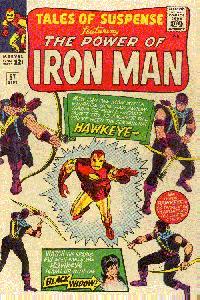
In September 1964, a villain named Hawkeye would appear in
Tales of Suspense #57. His name is Clint Barton, and he is something
of a high-tech Robin Hood with trick arrows. In this
issue he would fight Iron Man while being seduced by the Black
Widow
(a Russian spy who eventually turns good and leads The Avengers in
the future).
Hawkeye would eventually become a hero and get his own team to lead
called the West Coast Avengers. He was also a regular in a series
called Solo Avengers - later called Avengers Spotlight.
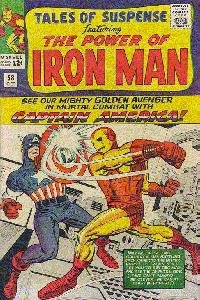

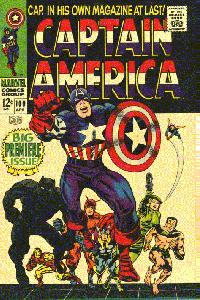
Captain America shows up one issue later in #58, and in Tales
of Suspense
#59, the title becomes a double feature with Captain America
and Iron Man. Starting with issue #70, Marvel did something
different with
this title. They decided to alternate the title's main characters. In
odd-numbered issues Iron Man would be the hero, and Captain
America
would be the hero in even-numbered issues. This kept up until the title turned
into Captain America with issue #100 (April 1968). Iron Man
would
then go on to co-star in a Iron Man and Sub-Mariner one shot, and then
move to his own series called The Invincible Iron Man in May
1968.

A very different hero would appear in Strange Tales #110
(1963). He was Dr. Strange. Although there have been
magicians in comics before, he was unique. His spells were not
done with the wave of a wand. Dr. Strange tapped into other
dimensions. But what was intriguing about this book were the spells
that Dr. Strange cast. They were very close
to 'real' magic spells that are found in established black arts. Stan Lee
claims he
just made up the Dr. Strange spells up without looking at occult
books. Weird,
eh?... maybe there is something to this occult stuff after
all (grin).
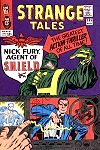
Another Marvel hero would be introduced in the Strange Tales comic,
although this one had no powers. His name was Nick Fury
and he first appeared in August 1965 in Strange Tales #135.
Nick was a part of a secret espionage group called S.H.E.I.L.D.
who, with their army of soldiers and high tech gadgets, could
keep an eye on and even defeat superpowered menaces. Nick Fury
himself is a very gruff character. He was an unshaven, cigar smoking,
eye-patch wearing, experienced WWII veteran, who was as tough as nails.
He took no guff, and accepted no excuses from anybody. Unquestionably
the hardest working man within S.H.I.E.L.D., he expected everyone
else to work their butts off, too.

It should be noted that Strange Tales originally showcased
Johnny Storm, The Human Torch from the Fantastic Four.
Dr. Strange came aboard regularly with issue #114. In #118 he first
appeared on the cover of Strange Tales. This title
would change it's name to Doctor Strange with issue #169.
Nick Fury would get his own title in 1968.
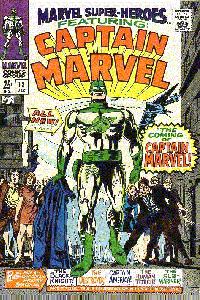
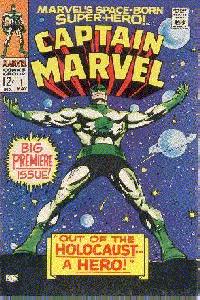
Marvel Comics also had it's heroes from outerspace. Marvel
Superheroes #12 (December 1967)
had the first appearance of Captain Marvel (December 1967). Yes,
you read that right, and no, he doesn't yell
"Shazam!" During a time when the original Captain Marvel was not in
print, Marvel Comics
decided to make use of the Captain Marvel name. This new character
was a spy from the Kree empire.
Because Earth had superheroes who could defeat Kree robots and soldiers,
they needed someone to watch us.
Soon after his appearance Captain Marvel got his own comic book. In
May 1968 Captain Marvel would
come out, just after two apperances in Marvel Superheroes. While on
Earth, Marvel would develop powers of
his own, and would become much more than a warrior/spy. Soon the Kree
empire would give Captain Marvel
his own uniform and a pair of Nega Bands that allowed him to replace
Hulk sidekick Rick Jones in
an alien dimension called the Negative Zone. He would eventually betray
this evil empire and help stop wars
they were involved with. He also met an entity called Epoch, was
given 'Cosmic Awareness' and
became the 'Protector of the Universe.' But in one of his battles,
Captain Marvel would come into contact with
a radioactive substance and would later get cancer. Despite all the great
scientific minds on Earth he would die of
cancer and stay dead (very rare in comic books).

In Fantastic Four #48 (March 1966) a new villain would appear. He
was a silver alien who came
to check out our planet. After visiting, he decided Earth was okay for his
master to eat it.
His name was The Silver Surfer and he would later turn against his
master and help save
Earth from becoming lunch. This story was a real break-through for comic
book stories.
It added different perspectives that were difficult for the readers to
understand or agree with, but were realistic and made sense. In this
particular story, the reader would assume the giant alien (Galactus)
coming to eat Earth was a 'bad guy.' Not so. This alien could only survive
by eating planets,
and because he was a giant and god-like being, the life of the planets'
inhabitants (us) meant nothing to him.
Do ticks on a cow mean anything to us? We take their "homes" and eat them
every day
as Big Macs and steak. Galactus felt the same way. I should mention
that Galactus ate the "life-giving
energy" of planets, not the crust itself. Unfortunetly without our planets
"life giving energy" we would die.
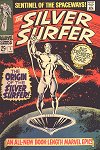
Silver Surfer was once an ordinary man called Norrin Radd, living peacefully on a planet called Zen-La. One day Galactus came to Zen-La and Norrin wanted to stop him from eating his planet. He made a deal with Galactus that if he became his hearld (servant) and helped him find planets to eat, Zen-La would be spared. Galactus agreed and turned Norrin Radd into the Silver Surfer. It was Norrin's intention to find uninhabited planets for Galactus to eat. But during his transformation, Galactus wiped out his memery clean. Silver Surfer had a vast amount of powers. First he was indestructable and extremely strong. He had the power cosmic that allowed him to do many things from simple force blasts to molecular reconstruction. He also had eyesight that could see things we could not, and could control his space-surf-board by thought. After helping the Fantastic Four defeat Galactus, Silver Surfer was "imprisoned" on Earth by Galactus. That is where the Silver Surfer series started (August 1968). He would later be freed from Earth and roam the stars. The Silver Surfer would also become a member of the superhero team called The Defenders.